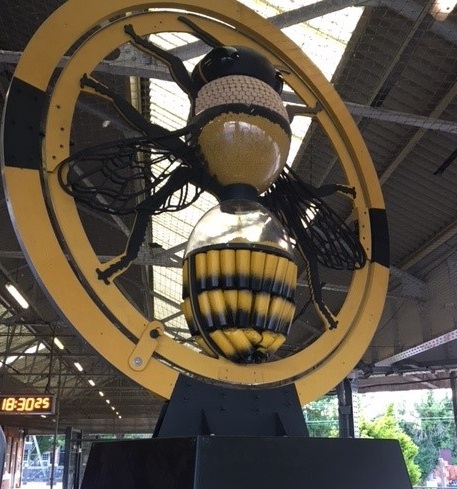A large sculpture highlighting the importance of bees has been installed at Clacton rail station.
The Essex and South Suffolk Community Rail Partnership worked with the Bee Friendly Trust and Greater Anglia to host the sculpture which was previously on display at London King’s Cross.
Made from recycled materials, it features a bee-shaped sand timer and the slogan ‘Time is running out’ to raise awareness of the importance of bees and other pollinators to human survival and the threats they face due to climate change and habitat loss.
Greater Anglia, its team of volunteer station adopters, and the community rail partnership are working to improve biodiversity at rail stations to offer local wildlife a safe refuge, including working with the Bee Friendly Trust on projects at 12 stations in Essex, including Alresford, Althorne, Bures, Clacton-on-Sea, Colchester, Great Bentley, Kirby Cross, Mistley, South Woodham Ferrers and Witham.
Jayne Sumner, rail engagement manager for the Essex & South Suffolk Community Rail Partnership, said, “Across Essex, rail stations are becoming very important spaces where we are supporting the volunteer station adopters in creating wonderful station gardens that not only look great, but are havens for wildlife, providing vital food, shelter, and breeding places.”
Dr Luke Dixon, co-founder of the Bee Friendly Trust, said, “Honey bees can fly up to three miles from the hive when out foraging for pollen and nectar, but in areas that are densely populated or over-farmed they sometimes struggle to find enough food.
“That’s why we’re working with railway authorities, community rail partnerships, and local groups across the UK to install bee-friendly flowering planters, fruit tree orchards and micro wildlife gardens on railway station platforms.”
In total, there are now 61 rail station gardens on Greater Anglia’s network. The total amount of railway land converted into garden on the Greater Anglia network is over 6,800 square metres. If each square metre of garden was put end-to-end they would stretch from London to Aberdeen.
“The railway is increasingly recognised by ecologists as a ‘green corridor’ which provides a sanctuary for many different kinds of flora and fauna,” said Alan Neville, Greater Anglia’s customer and community engagement manager.
“Therefore, it’s important that our stations are not ‘dead spots’ in the corridor and thanks to these projects, many stations are now helping to feed and house fragile wildlife populations as they move around the landscape, like mini service stations where they can top up on food or rest before moving on.”
In a recent survey, Greater Anglia station adopters reported a wide range of creatures visiting their stations including many different types of butterflies as well as bees, slow worms, bats, foxes, deer, and many varieties of birds, recording over 200 different species.
Image credit: Greater Anglia / istockphoto.com



